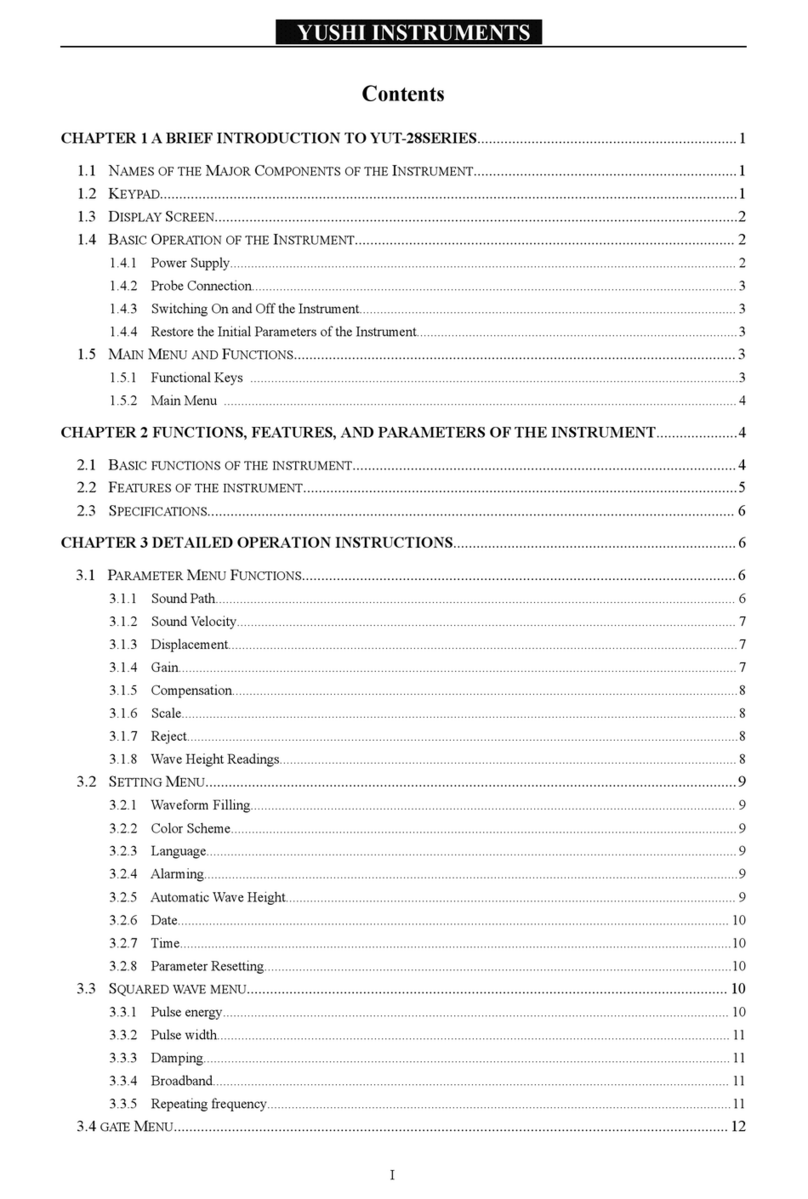
YUSHI INSTRUMENTS
3.3.1.1 Starting of Gate a ....................................................................................................................................11
3.3.1.2 Width of Gate a .......................................................................................................................................12
3.3.1.3 Height of Gate a......................................................................................................................................12
3.3.1.4 Mode of Gate a........................................................................................................................................12
3.3.1.5 Display Choice........................................................................................................................................12
3.3.2 Gate B Menu..............................................................................................................................................13
3.3.2.1 Starting of Gate b ....................................................................................................................................13
3.3.2.2 Width of Gate b.......................................................................................................................................13
3.3.2.3 Height of Gate b......................................................................................................................................13
3.3.2.4 Mode of Gate b .......................................................................................................................................14
3.3.2.5 Measuring Point.........................................................................................................................................14
3.4 PROBE MENU ...........................................................................................................................................14
3.4.1 Dual Probes...................................................................................................................................................14
3.4.2 Probe Zero.....................................................................................................................................................15
3.4.3 Probe K Value ...............................................................................................................................................15
3.4.4 Front Distance...............................................................................................................................................15
3.4.5 Work Piece Thickness ...................................................................................................................................16
3.5 CURVE MENU............................................................................................................................................16
3.5.1 DAC echo......................................................................................................................................................16
3.5.2 Gate A start....................................................................................................................................................17
3.5.3 RL.................................................................................................................................................................17
3.5.4 SL...............................................................................................................................................................17
3.5.5 EL ..............................................................................................................................................................17
3.6 MEMORY MENU .......................................................................................................................................17
3.6.1 Memory Number........................................................................................................................................18
3.6.2 Call-out .........................................................................................................................................................18
3.6.3 Storage ..........................................................................................................................................................18
3.6.4 Deletion.........................................................................................................................................................18
3.6.5 Communication.............................................................................................................................................19
3.7 OPERATION OF OTHER SPECIAL FUNCTIONAL KEYS.................................................................................19
3.7.1 Automatic Gain .............................................................................................................................................19
3.7.2 Freezing ........................................................................................................................................................20
3.7.3Wave Peak Memory.......................................................................................................................................20
3.7.4 Full Screen ....................................................................................................................................................20
CHAPTER 4 APPLICATION OF TESTING...............................................................................................20
4.1 CALIBRATION METHOD AND STEPS OF THE INSTRUMENT.........................................................................20
4.2 ZERO CALIBRATION OF THE STRAIGHT BEAM PROBE...............................................................................21
4.2.1 Calibration Procedures..................................................................................................................................21
4.2.2 Operation Steps.............................................................................................................................................21
4.2.3 Measurement of the Sound Velocity of the Material .....................................................................................23
4.3 CALIBRATION OF THE ANGLE BEAM PROBE .............................................................................................23
4.3.1 Calibration Procedures..................................................................................................................................23
4.3.2 Operation Steps.............................................................................................................................................23
4.4 MAKING OF DAC CURVE .........................................................................................................................27
































